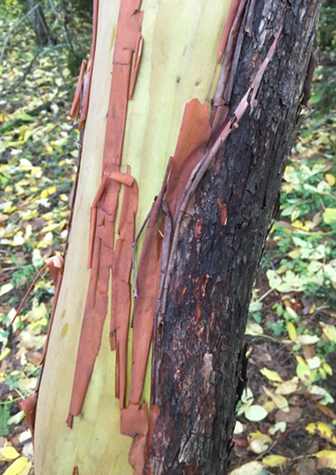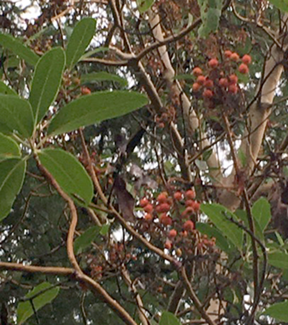Grandmother Madrone


Treekeepers’ Tree of the Month
by Josie Koehne, Treekeepers
The Pacific madrone (arbutus menziesii), a Pacific coast native, is like a stubborn grandmother who refuses to be moved from her run-down old farmhouse to a fancy new condo where she can be lovingly cared for by those who love her. She prefers rocky soils and arid areas often in the middle of a dense Doug fir stand, or an inhospitable roadside bank rather than a well-tended and watered garden spot.
She sheds her papery orangey-red bark raggedly and completely in some places revealing a very smooth greenish-gray to light salmon-colored trunk underneath, and she is often also as gnarled and twisted as an old grandma as she reaches to bask in the sun.

Madrones hate being transplanted and prefer to be facing in the same orientation as where they were growing originally. OSU Extension Service says one theory has it that they rely on a complex relationship with fungal filaments in the soil and the tree’s root system, called myccorhizae, so if you’re going to buy or dig up one of your young madrones (under 12”), be sure to dig up the soil from a nearby mature madrone and gently spread out the roots when planting.

Madrones are evergreen and produce small clusters of white flowers and edible but tasteless (to us) red berries that attract birds (especially woodpeckers and sapsuckers), bees, and insects. The evergreen leaves can be applied topically in the form of a poultice to heal burn injuries and wounds and are often used for treating stomach aches, cramps, colds, and other conditions. In the wild, they grow to 50-125 feet, with trunks 24 inches or more in diameter, but they do not reach those heights outside their native areas.
When other competing trees and understory vegetation are killed off in a wildfire, the madrone actually thrives after a severe burn. Although the upper portion of the madrone dies in a blaze, deep underground in the heartwood is an adaptive, regenerative nutrient-packed structure called the burl—which usually survives below ground—from which dozens of shoots can sprout, allowing the madrone to take advantage of the new space and sunlight to out-compete other tree species.
Due to our wet winters, the tree is susceptible to several kinds of destructive fungal infections and pathogens, some producing brown to black leaf discoloration. You can plant madrones from seed however, by collecting the berries in the late fall and drying them out over the winter. Propagation tips are provided on a Washington State University page here. Read more at Gardening Know How: Madrone Tree Information – How To Care For A Madrone Tree.
These photos are of madrones growing in our woods near Hagg Lake. They can also be found at Cooper Mountain Nature Park. Madrones can also be found in the Cedar Mill area, in the Estates at Leahy Park property where developers have plans to cut down many trees.
Protecting mature trees is the mission of Treekeepers of Washington County. Email us or visit our website to find out more.





